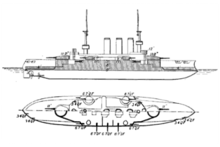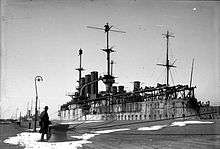SMS Preussen (1903)
 Preussen in 1907 | |
| History | |
|---|---|
| Name: | Preussen |
| Namesake: | Prussia |
| Builder: | AG Vulcan Stettin |
| Laid down: | April 1902 |
| Launched: | 30 October 1903 |
| Commissioned: | 12 July 1905 |
| Fate: | Scrapped in 1931 |
| General characteristics | |
| Class and type: | Braunschweig-class pre-dreadnought battleship |
| Displacement: | 14,394 t (14,167 long tons) |
| Length: | 127.7 m (419 ft) |
| Beam: | 22.2 m (72 ft 10 in) |
| Draft: | 8.1 m (26 ft 7 in) |
| Propulsion: | |
| Speed: | 18 knots (33 km/h; 21 mph) |
| Range: | 5,200 nautical miles (9,600 km; 6,000 mi); 10 knots (20 km/h; 10 mph) |
| Complement: |
|
| Armament: |
|
| Armor: |
|
SMS Preussen[lower-alpha 1] was the fourth of five pre-dreadnought battleships of the Braunschweig class in the Kaiserliche Marine (the German Imperial Navy) laid down in 1902 and commissioned 1905. She was named for the state of Prussia[lower-alpha 2] Her sister ships were Braunschweig, Elsass, Hessen, and Lothringen.
Preussen served in the II Battle Squadron of the German High Seas Fleet for the majority of her career. She participated in a fleet advance in December 1914 in support of the Raid on Scarborough, Hartlepool and Whitby during which the German fleet encountered and briefly clashed with a detachment of the British Grand Fleet. She had been temporarily assigned to guard ship duties in the Baltic in May 1916, and so missed the Battle of Jutland. Due to her age, she did not rejoin the fleet, and instead continued to serve as a guard ship until 1917, when she became a fleet tender.
After the war, Preussen was retained by the re-formed Reichsmarine and converted into a depot ship for F-type minesweepers. She was stricken in April 1929 and sold to ship breakers in 1931. A 63-meter (207 ft) section of her hull was retained as a target; it was bombed and sunk in 1945 by Allied bombers at the end of World War II, and subsequently scrapped in 1954.
Design

Preussen was 127.7 m (419 ft) long overall and had a beam of 22.2 m (73 ft) and a draft of 8.1 m (27 ft) forward. The ship was powered by three 3-cylinder vertical triple expansion engines that drove three screws. Steam was provided by eight naval and six cylindrical boilers, all of which burned coal. Preussen's powerplant was rated at 16,000 metric horsepower (15,781 ihp; 11,768 kW), which generated a top speed of 18 knots (33 km/h; 21 mph).[1]
Preussen's armament consisted of a main battery of four 28 cm (11 in) SK L/40 guns in twin gun turrets,[lower-alpha 3] one fore and one aft of the central superstructure.[2] Her secondary armament consisted of fourteen 17 cm (6.7 inch) SK L/40 guns and eighteen 8.8 cm (3.45 in) SK L/35 quick-firing guns. The armament suite was rounded out with six 45 cm (18 in) torpedo tubes, all mounted submerged in the hull.[3]
Service history
.jpg)
Preussen was laid down in 1902, at the AG Vulcan in Stettin under construction number 256. The fourth unit of her class, she was ordered under the contract name "K" as a new unit for the fleet. The ship cost 23,990,000 marks.[1] Preussen was launched on 30 October 1903 and commissioned into the fleet on 12 July 1905.[3]
After commissioning in 1905, Preussen was assigned to the II Battle Squadron of the German fleet. There she joined her sisters Braunschweig, Elsass, and Hessen.[4] By the end of 1911, three of the four new Helgoland-class dreadnoughts had entered active duty with the I Squadron; the only pre-dreadnought remaining in I Squadron was Preussen's sister Elsass. Preussen and seven other Braunschweig and Deutschland-class ships made up the II Squadron.[5] Preussen was present during the fleet cruise to Norway in July 1914, which was cut short by the assassination of Archduke Franz Ferdinand and subsequent rise in international tensions. On 25 July the ship's crew was made aware of Austria-Hungary's ultimatum to Serbia; Preussen left Norway to rendezvous with the rest of the fleet the following day.[6]
World War I
After the outbreak of war in August 1914, the High Seas Fleet conducted a series of operations designed to lure out a portion of the numerically superior British Grand Fleet and destroy it.[7] By achieving a rough equality of forces, the German navy could then force a decisive battle in the southern portion of the North Sea.[8] The first such operation in which the High Seas Fleet participated was the raid on Scarborough, Hartlepool and Whitby on 15–16 December 1914.[9] The main fleet acted as distant support for Rear Admiral Franz von Hipper's battlecruiser squadron while it raided the coastal towns. On the evening of 15 December, the fleet came to within 10 nmi (19 km; 12 mi) of an isolated squadron of six British battleships. However, skirmishes between the rival destroyer screens in the darkness convinced the German fleet commander, Admiral Friedrich von Ingenohl, that the entire Grand Fleet was deployed before him. Under orders from Kaiser Wilhelm II, von Ingenohl broke off the engagement and turned the battlefleet back towards Germany.[10]
Preussen, though assigned to the II Squadron, missed the Battle of Jutland on 31 May–1 June 1916. She had been temporarily transferred to the Baltic to serve as a guard ship. Her sister ship, Lothringen, also missed the battle, as she had been deemed to be in too poor a condition to participate in the fleet advance.[11] Jutland proved to Vice Admiral Reinhard Scheer, the fleet commander, that the pre-dreadnought battleships were too vulnerable to take part in a major fleet action, and so detached the II Squadron from the High Seas Fleet.[12] As a result, Preussen remained in service as a guard ship in the Baltic. From 1917 to the end of the war, she served as a fleet tender based in Wilhelmshaven.[3] Preussen briefly held Edouard Izac, a US Navy sailor captured after his ship was sunk by U-90, in June 1918; Izac would go on to escape from a German prisoner of war camp and win the Medal of Honor.[13]
Post-war career

The Treaty of Versailles, which ended the war, specified that Germany was permitted to retain six battleships of the "Deutschland or Lothringen types."[14] Preussen was among those ships chosen to remain on active service with the newly reformed Reichsmarine.[3] The ship was converted into a parent ship for F-type minesweepers at the Kriegsmarinewerft in Wilhelmshaven in 1919; the ship was disarmed and platforms for holding the minesweepers were installed.[15]
Preussen served in this capacity with the newly reformed Reichsmarine until 1929. She was stricken from the naval register on 5 April 1929; the Reichsmarine sold her to ship breakers on 25 February 1931 for 216,800 Reichsmarks. Preussen was subsequently broken up for scrap in Wilhelmshaven, though a 63 m (207 ft) length of her hull was retained as a testing target for underwater weapons, including torpedoes and mines. The section of hull was nicknamed "SMS Vierkant ("SMS Rectangle"). Allied bombers attacked and sank the section of Preussen's hull in April 1945. It was eventually raised and scrapped in late 1954.[3]
Notes
Footnotes
- ↑ "SMS" stands for "Seiner Majestät Schiff" (English: His Majesty's Ship).
- ↑ Prussia was spelled Preußen in German, using the German eszett (ß, or "sharp S").
- ↑ In Imperial German Navy gun nomenclature, "SK" (Schnelladekanone) denotes that the gun is quick firing, while the L/40 denotes the length of the gun. In this case, the L/40 gun is 40 caliber, meaning that the gun is 40 times as long as it is in diameter. See: Grießmer, p. 177.
Citations
- 1 2 Gröner, p. 18.
- ↑ Hore, p. 68.
- 1 2 3 4 5 Gröner, p. 20.
- ↑ Hurd, p. 27.
- ↑ Scheer, p. 8.
- ↑ Tarrant, p. 27.
- ↑ Gardiner & Gray, p. 136.
- ↑ Tarrant, p. 31.
- ↑ Tarrant, pp. 31–33.
- ↑ Scheer, p. 140.
- ↑ Scheer, p. 187.
- ↑ Mikaelian & Wallace, pp. 57–58.
- ↑ Treaty of Versailles Section II: Naval Clauses, Article 181.
- ↑ Gröner, pp. 18–20.
References
Books
- Gardiner, Robert; Gray, Randal, eds. (1985). Conway's All the World's Fighting Ships: 1906–1921. Annapolis: Naval Institute Press. ISBN 978-0-87021-907-8.
- Grießmer, Axel (1999). Die Linienschiffe der Kaiserlichen Marine [The Battleships of the Imperial Navy] (in German). Bonn: Bernard & Graefe Verlag. ISBN 978-3-7637-5985-9.
- Gröner, Erich (1990). German Warships: 1815–1945. Annapolis: Naval Institute Press. ISBN 978-0-87021-790-6.
- Hore, Peter (2006). The Ironclads. London: Southwater Publishing. ISBN 978-1-84476-299-6.
- Hurd, Archibald (1912). The Command of the Sea. London: Chapman & Hall.
- Mikaelian, Allen; Wallace, Mike (2003). Medal of Honor: Profiles of America's Military Heroes from the Civil War to the Present. New York: Hyperion. ISBN 978-0-7868-8576-3.
- Scheer, Reinhard (1920). Germany's High Seas Fleet in the World War. London: Cassell and Company. OCLC 2765294.
- Tarrant, V. E. (2001) [1995]. Jutland: The German Perspective. London: Cassell Military Paperbacks. ISBN 978-0-304-35848-9.
Journals
- Palmer, W., ed. (1906). "Germany: The Navy". Hazell's Annual. London: Hazell, Watson, & Viney: 196–197.
Further reading
- Dodson, Aidan (2014). "Last of the Line: The German Battleships of the Braunschweig and Deutschland Classes". Warship 2014. London: Conway Maritime Press: 49–69. ISBN 978-1591149231.